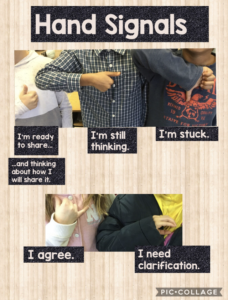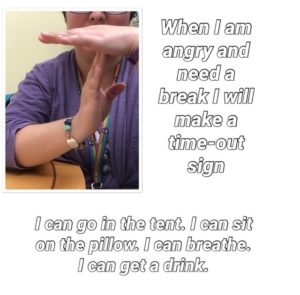January 30th, 2020
I’ve worked at a number of elementary schools over the course of my career as an itinerant teacher. I’ve always been impressed with grade, division, and staff teams who commit to using shared language to help students to learn new concepts and to express their thinking. In her book “Number Talks: Whole Number Computation”, Sherry Parrish provides a helpful tip of having students use a silent thumbs-up in front of their chests rather than shouting out answers or raising hands. This allows for more processing time and greater participation by more introverted students or those who do not yet have the confidence or skills to share their thinking verbally. During math and number talks, many teachers are using a common set of hand-signs to help children to participate and express their thinking during the lesson.
 Classroom teacher Hillary Walter, in collaboration with former Learning Support Teacher Lyndsay Buehler, created this visual anchor for math talks, using the PicCollage app on iPad. Having a visual anchor to support students as they learn this common language of hand signals is incredibly helpful for ELLs and ALL students.
Classroom teacher Hillary Walter, in collaboration with former Learning Support Teacher Lyndsay Buehler, created this visual anchor for math talks, using the PicCollage app on iPad. Having a visual anchor to support students as they learn this common language of hand signals is incredibly helpful for ELLs and ALL students.
I created this visual to support a student with a refugee background who was struggling with his behaviour and could not find the words needed to express his feelings when he was overwhelmed and needed a break. Trauma researchers now know that students who have experienced trauma, when triggered, experience a shut down of their left frontal cortex, particularly Broca’s area (the centre for speech). It helped school staff to have this common (signing) language to use to communicate with this student.
Purposefully using common language in a school can include terminology related to social skills, conflict resolution, mental wellness or character education, such as those used in the fabulous programs HERO traits by Plasticity Labs and Umbrella project by Dr. Jen. It can include hand signs, visuals, or commonly used terms and phrases to help students understand expectations and to communicate with others. Using common language gives our English Language Learners a hand up in comprehending the world around them.
As with most strategies that help our English Language Learners, agreeing upon some common language for key social and academic learning usually ends up helping everyone.
Tags: Language · vocabulary

